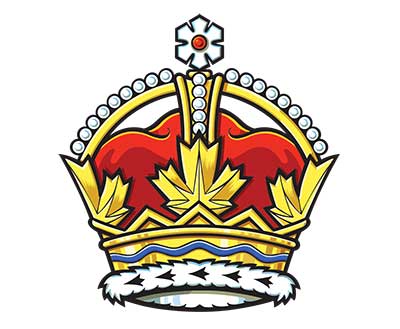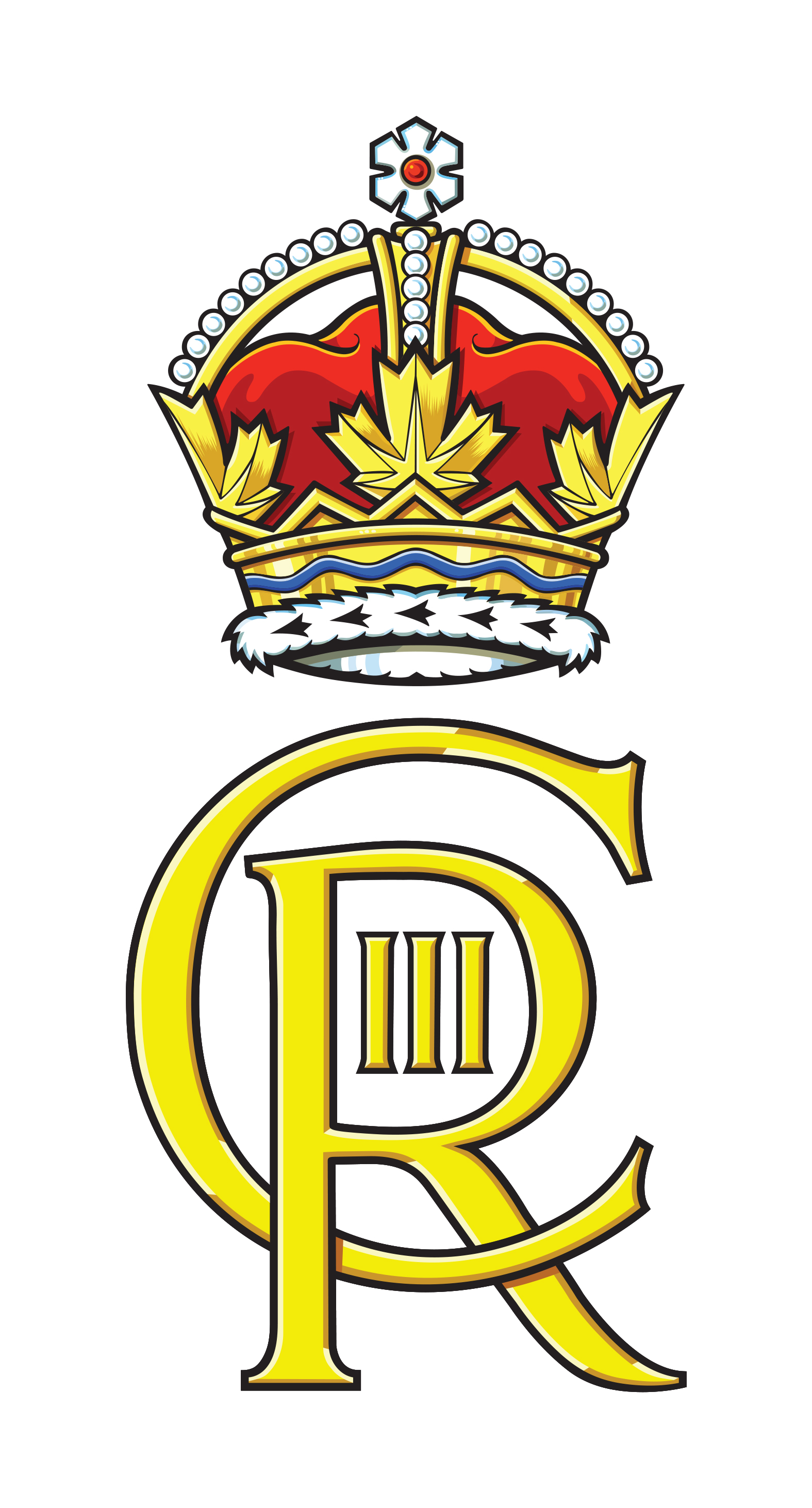Canadian Royal Crown and Royal Cypher
The Canadian Royal Crown and the Royal Cypher are 2 important royal symbols that represent the Crown in Canada. The Canadian Royal Crown is a symbol of the Sovereign’s authority while the Royal Cypher is a personal device used to identify the Sovereign.
On this page
The Canadian Royal Crown

The Canadian Royal Crown features a familiar design resembling the English Royal Crown in the Tudor style, while incorporating distinctly Canadian elements.
The Crown’s rim bears stylized maple leaves, the quintessential symbol of Canada, as well as rising and falling peaks representing Canada’s varied landscape with its many mountain ranges and river valleys. The wavy blue line represents the country’s lakes and rivers, as well as the 3 oceans that encompass its borders. This also alludes to the Indigenous teachings reminding us that water is the lifeblood of the land and emphasizes the importance of the environment to all Canadians. The red cap and its trim in white ermine fur also provide a nod to the colours of the National Flag of Canada. Finally, the Crown is topped with a stylized snowflake, representing snowy winters. This snowflake resembles the insignia of the Order of Canada, one of the country’s highest honours.
The Canadian Royal Crown is an important symbol of the Sovereign’s authority, as well as the state’s power and the principle of the Canadian monarchy. Its design was created by the Canadian Heraldic Authority and approved by His Majesty King Charles III in April 2023.
Canada had previously used artistic representations of the Royal Crown that followed the personal preference of the Sovereign, notably the heraldic rendition of St. Edward’s Crown used during the reign of Queen Elizabeth II.
The Canadian Royal Crown was designed so that Canada would have its own distinctive Royal Crown that would represent the country and the particular identity of the Crown in Canada. Similarly, Scotland also has its own Royal Crown that is used in some Royal emblems. Outside of the United Kingdom though, Canada was the first Commonwealth Realm to create a distinctive Royal Crown.
Introduced in 2023 at the start of the reign of King Charles III, the Canadian Royal Crown is intended to be a perennial emblem that will be used during the reigns of all future kings and queens of Canada, without needing to change Canadian emblems.
Read more about the Canadian Royal Crown.
Past Royal Crowns
Other than the Canadian Royal Crown, there are 2 main heraldic representations of the Royal Crown that have historically been used in Canada: the St. Edward’s Crown and the Tudor Crown.
The St. Edward’s Crown
The St. Edward's Crown, a representation of which was used in royal emblems during the reign of Queen Elizabeth II, is a real object which is used for the coronation of the Sovereign. It contains much of the crown first made in 1661 for the coronation of King Charles II.
Constructed of solid gold, the Crown's design includes a base, with 4 crosses patté alternating with 4 fleurs-de-lis, within which is a velvet cap with ermine border and 2 arches above and surmounted by a cross, all set with 444 precious stones. Formerly the stones were hired for each coronation and then detached, leaving only the frame. However, in 1911, the jewels were set permanently.
A number of changes were made for the coronations of James II (a new monde, that is, the orb that surmounts the crown) and William III (the base being changed from its original circular form to a more natural oval one). The Crown was also made slightly smaller to fit the head of George V, the first monarch to be crowned with St. Edward's Crown in over 200 years. The Crown was, however, carried in procession at other coronations at which it was not actually worn. The St. Edward's Crown weighs 4 lb 12 oz (2.2 kg).
Though the physical St. Edward's Crown is property of the Sovereign, its artistic representation was used by many Commonwealth realms during the reign of Queen Elizabeth II as an indication of each country's respective royal authority, thus appearing on coats of arms, badges for military and police units, and emblems for government departments and private organizations with royal associations.
In this use, the St. Edward’s Crown replaced the Tudor Crown by the command of Queen Elizabeth II in 1953. Upon his accession to the throne in 2022, King Charles III chose to return to the Tudor Crown as the official representation of the Royal Crown during his reign. Canada briefly followed suit before the Canadian Royal Crown was unveiled in May 2023.
The Tudor Crown
Unlike the St. Edward’s Crown, the Tudor Crown is not an actual physical object. Its design is however inspired by the historical crown used by King Henry VIII (hence the name Tudor Crown), which was destroyed in 1649 during the English Civil War. Heraldic representations of the Royal Crown do not need to correspond to an existing physical object in order to symbolize the authority of the Monarch.
Use of the Royal Crown in any design, including the Canadian Royal Crown, must receive the personal permission of the Sovereign. Permission is sought through the Chief Herald of Canada at the Canadian Heraldic Authority, which is part of the Office of the Secretary to the Governor General.
The Royal Cypher

The Royal Cypher is a personal device identifying the Sovereign, like a signature, composed of the Sovereign’s monogram surmounted by the Royal Crown.
King Charles III’s monogram consists of the intertwining initials "C" and "R" which represent his name "Charles" and "Rex," the Latin word for king. Because His Majesty is the third Charles to reign, "III" has been added in the middle of the initials. In the current version of the Royal Cypher, the Tudor Crown, last used in the emblems of His Majesty’s grandfather King George VI, is placed above the initials.
The version of the Royal Cypher used in Canada features the Canadian Royal Crown. This crown will also serve for the royal cyphers of all future kings and queens of Canada.
The Royal Cypher is used in the insignia of orders, decorations and medals, and on various badges.